What lies in the empty spaces between the interstates and major cities of the American West? As Ryan Ver Berkmoes finds, a US 50 road trip takes you on a slow tour through ghosts from America’s past — some whose memory we’ve given a nice shiny polish over time, while others we’ve tried to rub away completely.
For at least the fifth time that day, I veered off the pavement, my car enveloped in a cloud of dust while gravel thunked against the underside. In the center of the road, I grabbed the kind of photo that causes a spike in my travel pheromones: a shot looking down the middle of the deserted highway, the road snaking off into nothingness at the horizon.
It had been a full day. I’d reverse commuted my way out of the Bay Area and bombed through an already baking Sacramento before 9 am. My goal was US 50, the road up into the Sierra. But I had no interest in the Gold Country hills, the high alpine peaks or even Lake Tahoe. Rather, I wanted to hit Nevada and the open road, where US 50 wanders east across four states for a numerically inspiring 1,666 miles, managing to avoid major population centers all the way to Kansas City.
As I climbed the Sierra grades, having escaped the last Sacramento exurb, I was once again surprised at the unexpected beauty of the silvery American River and the sharp curves of busy US 50. While the prospect of a drive across a forgotten swath of America was my reason for the trip, I also worried that my fantasy of long hours lost in the contemplative nothingness of the open road would be spoiled by the modern age. Had Instagrammers been seduced by “The Loneliest Road in America” schtick (complete with hashtag) peddled by Nevada’s US 50 boosters? Would I find self-anointed influencers arrayed along the roadside dolefully peering out into the middle distance behind comped designer shades?
Happily, my cynical fears were misplaced, and while US 50 isn’t very lonely, it is a mainline into a forgotten America we can ill afford to forget.
Day 1: Nevada
I paused only for stoplights at Lake Tahoe and wound down the arid side of the Sierra to the shadeless streets of Carson City. I hung a right just past a downtown storefront psychic and pointed myself east, in a hurry to, well, nowhere. Too much of a hurry as it turned out for soon my rearview mirror was alive with flashing blue and red lights. I escaped with only a warning, despite the admonition from one of the cheeriest cops I’ve ever encountered: “Normally doing 67 in a 45 zone will get you a citation every time.” I put my good fortune down — at least in part — to my unctuous middle-aged white-guy palaver, not realizing the ways I’d be confronting my own ethnicity in the days ahead.
An hour east, I stopped in Fallon, a charmless crossroads city at the junction of US 395. I was lured into the local museum as a means to start marinating in the vibe of the region. Normally I’m immune to the charms of these local museums, having seen hundreds during years as a guidebook writer — my spirit crushed by dreary displays of stained quilts, rusty farm implements, rickety pioneer-era furniture one termite away from collapse, and the overwhelming ennui left behind by generations of school kids dragooned into looking at this crap.
So I was delighted to discover that the Churchill County Museum is a few cuts above the very low norm. Sure, it has oodles of musty pioneer leftovers, but it also has an engaging desert display where the stuffed critters are less desiccated than usual. In the back was pay dirt: an exhibit about a larger-than-life local road-builder named Andy Drumm who could have stepped out of a John D. MacDonald novel, all bluster and bombast as he ranged around his barren county carving out early versions of US 50. Now all but forgotten except for this backroom exhibit, you could still feel him straining at the boundless confines of middle Nevada.
For portions of its 400 miles in Nevada, US 50 follows the route of the Pony Express and later the stagecoach route of the Overland Trail. Both were made redundant by progress: the first transcontinental telegraph line killed the Pony Express (which only lasted 17 months) while the first transcontinental railroad took out the stagecoaches. One hundred years ago, parts of the surviving dusty tracks became segments of the Lincoln Highway, the early transcontinental route promoted with gleeful abandon by Carl Fisher, one of the great American hucksters.
Sand Spring Station was a Pony Express and stagecoach stop that is the very definition of desolation, and we’re not talking about the kind of magnificent desolation Buzz Aldrin waxed on about on the moon. A few rock walls and foundations amidst a cactus-strewn sandy plain are all that are left. It’s easy to imagine the bleak lives of those stationed here — signage at the ruins includes this stark assessment from a visiting Englishman in 1860:
“The water near this vile hole was thick and stale with sulphury salts: it blistered even the hands. The station house was…roofless and chairless, filthy and squalid, with a smokey fire in one corner, and a table in the centre of an impure floor, the walls open to every wind, and the interior full of dust. Of the employees, all loitered and sauntered about…as cretins, except one, who lay on the ground crippled and apparently dying by the fall of a horse on his breast bone.”
Minus the staff, the scene is little changed today. Other than wind, the only sound is the distant buzz of ATVs cavorting on the nearby brilliant white dune of Sand Mountain and the much more distant roar of fighter jets at the Navy’s TOPGUN flight school. You tread carefully, lest you hear the rattle of a rattlesnake.
I reveled in the eastern two-thirds of Nevada’s share of the road. Although never as lonely as the hype would promise — a truck or pickup roars past you at least every five minutes — it is a road for rumination and forgetting. Forgetting there’s a world beyond the horizon-filling expanses of desert. Forgetting where you came from and where you’re going. And, as I’d see the next day, forgetting about what you’re doing today.
The little towns along US 50 wear forlorn and hapless on their sleeves. At Austin (population 190), the tourist office was abandoned. Inside, a few forgotten boxes were improbably filled with old brochures touting travel to “lush and green” Ireland. Ely, Nevada (population 4200), feels forgotten from the first glimpse of the enormous mountains of strip mine tailings on its outskirts. I stayed the night at the Hotel Nevada, a tired six-story casino in the center of town that dates to 1929. Inside the lobby, a battered and ancient Smokeeter-brand air filter roared ineffectually overhead, obviously gorged on decades of cigarette smoke. From deep in the grey clouds obscuring the slot machines came violent coughs that reminded me of the unfortunate drummer in This Is Spinal Tap who choked on his own vomit. Outside, the burnt-out bulbs on the once-glitzy facades of Ely’s other forlorn casinos outnumbered those still feebly blinking.
But amidst the squalor, there was a generosity of spirit. While waiting for the creaking elevator, a clearly drunk man beside me handed me a well-thumbed coupon and said with real cheer, “You can use this for a Bud Light or a frozen margarita!” as he pointed at the nearby bar where the tenure of the patrons hunched on the stools was probably measured in hours, if not days.
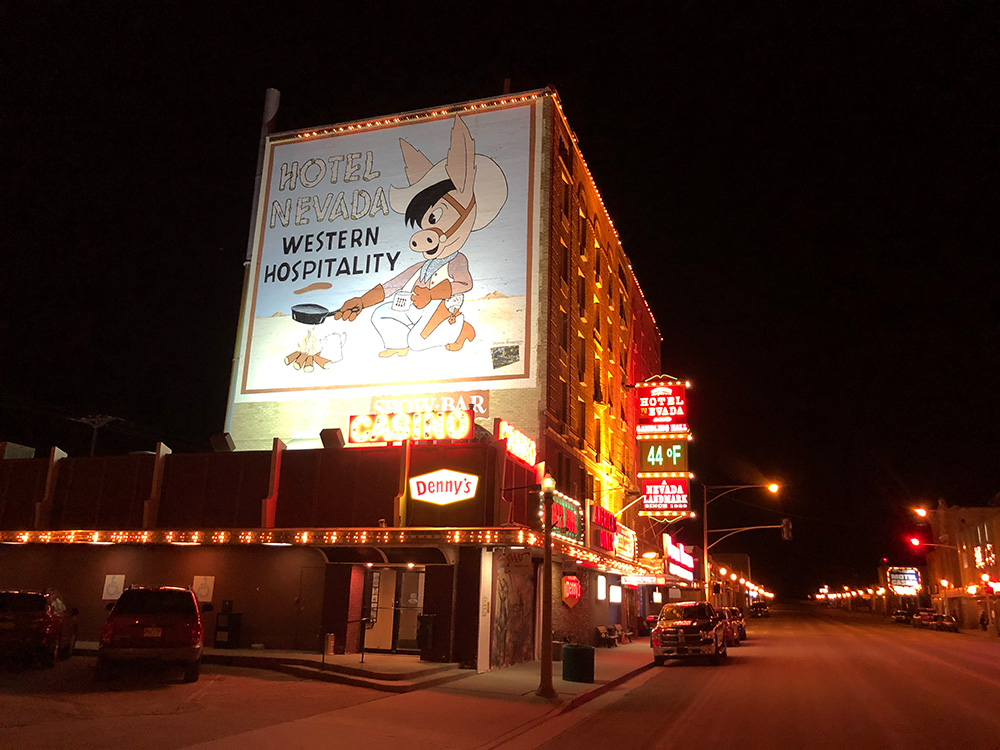
Day 2: Utah
Southeast of Ely, US 50 continues through vast and edifying emptiness. An occasional sign indicates an abandoned ranch or a modern prison is hidden amidst the hills and valleys which vanish off into the distance.
I listened to a podcast as I drove out of Ely to the day’s first goal. Order 9066 is an eight-part show about the internment of people with Japanese ancestry by the US government during WWII. Through interviews with survivors, it details what happened when they were taken from their West Coast homes and sent to the euphemistically named “internment camps” scattered about the most desolate and inaccessible regions of the American west. More than two-thirds of the 120,000 were US citizens, whose rights were simply forgotten overnight.
One of the camps, Topaz, was 100 miles east of the border into Utah in open and featureless flatlands. I stair-stepped off US 50 along increasingly uninviting rural dirt roads for a few miles until I saw the first official sign suggesting that there had once been a concentration camp here with a population of 11,000 men, women and children. The bland green sign reading “Topaz Relocation Site” pointed to a parking area amidst the scrub.
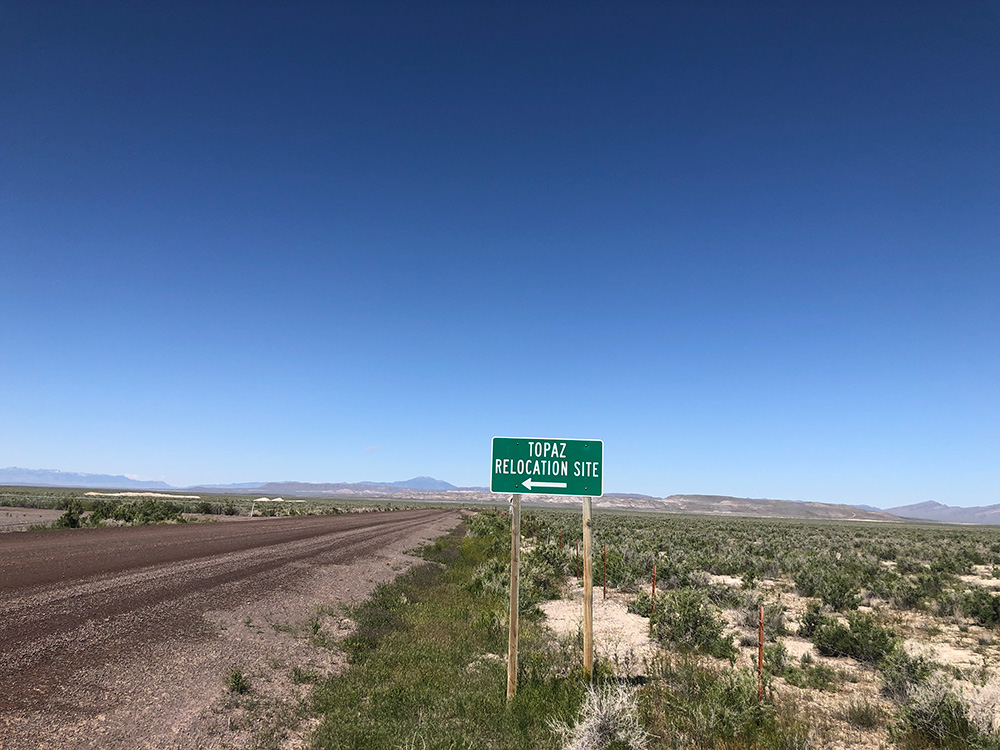
A few plaques and markers remained from the kinds of ceremonies where a few minor luminaries give desultory speeches and then leave, never to return. There is no visitor center at Topaz and very little in the way of explanatory signs. There’s no cell signal either, so if you haven’t downloaded some info, you’re out of luck.
Little is left of Topaz. On the podcast survivors talk about the flimsiness of the uninsulated buildings in terms not unlike those used to describe Sand Spring Station back in Nevada. Now-elderly people describe how their families lost everything while they were in the camps from 1942 through 1945. Their white neighbors stole their houses and businesses. Banks seized property and possessions for missed loan and mortgage payments — something impossible to accomplish from inside barbed wire fences.
President Franklin Roosevelt compromised with right-wing politicians and media in California who demanded the removal of anyone with Japanese heritage: Roosevelt allowed for internment, the right quieted their opposition to his other programs. Openly racist jeers and hatred from whites was virulent, and uncomfortably resonates with today’s news. But amidst the outrages and indignities there were also moments of humanity and grace when white friends and neighbors showed extraordinary compassion and generosity to help the internees.
The views from the once-crowded concentration camp are as bleak today as they were 75 years ago: a flat, featureless landscape and distant ring of low, snow-capped mountains. There’s nothing to stop the wind that blows 24/7. A slow-moving distant white dot is a semi on US 50.
Among the many recollections in Order 9066 (it’s named for the order signed by FDR that started the round-ups), a man recalls how he and his brother — then both young children — would scour the camp for magazines. They’d tear out the pages with chewing gum ads and put them in their mouths and start chewing. They’d imagine the resulting pulp tasted like spearmint.
My next goal for the day was a place with an even darker past than Topaz. To reach it though, would require me to take the interstate. I-70 joins old US 50 in the eastern half of Utah and it carries both monikers for this long stretch. I zipped up the on ramp and joined the 80-mph torrent of vehicles. Glimpses of natural beauty would flit past my windows. But there would be no stopping for the kind of wondrous open-road photos that were a delight up until now.
Exit 182 to US 191 could not come soon enough. I joined the caravans headed south to Arches National Park, one of the park system’s crown jewels. A few miles short, I pulled out of the flow into a muddy and unmarked clearing. Although it’s on the National Register of Historic Places and is one of the most notorious sites in the US, it appears on few maps.
In 1942, as the nation’s 10 internment camps were filling up with people of Japanese descent, the first protests began. Some internees protested the wholesale abuse of their rights as US citizens, others refused the draft, questioning why they should fight for a country that had destroyed their lives and the lives of their families. In late 1942, the first of 49 men (some of whom were decorated WWI veterans) arrived at this dismal spot, which was desolate even by the desolate standards of the west. An abandoned government camp was turned into what was unofficially named the Moab Isolation Center. Barely acknowledged by the bureaucracy, the camp was an American gulag where citizens were brought without trial or due process. One inmate recalled the camp director telling him that anyone could die in the Moab camp, and nobody would find the body.
In 1943 calmer heads ordered the camp closed. The surviving men were eventually returned to their families in the internment camps.
Today, the site of these horrors is a shabby open field. An explanatory sign lies uprooted in the weeds. Next to the line “May this sad, low point in the history of our democracy never be forgotten, in the hope that it will never happen again,” someone has scratched “Patriot Act.”
A day of deep emotion ended just over the Colorado border in Grand Junction. Amidst outlets of possibly every budget and midrange chain motel and hotel in America, I found a sweet little indie with passionate owners, great rooms and cheap prices: the Balanced Rock Inn. It’s just across from the Union Pacific mainline. I walked over and watched the sunset glint off the tracks.
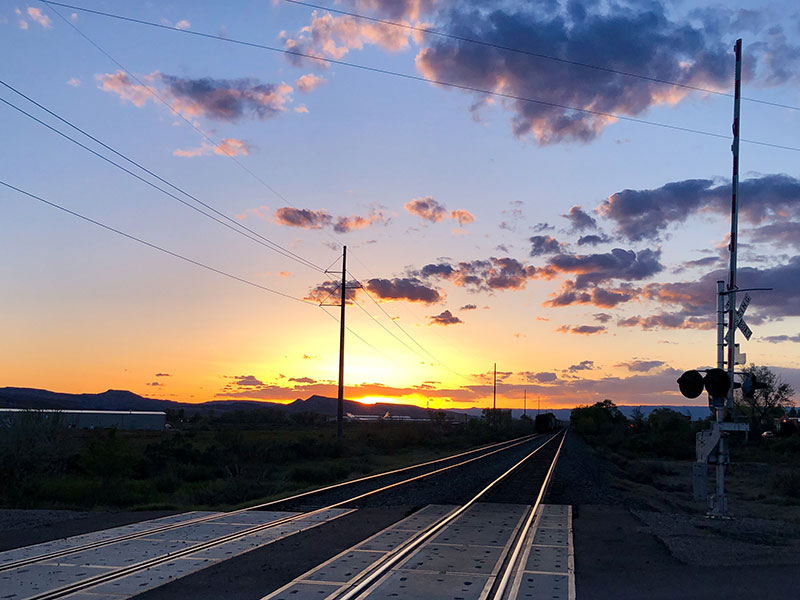
Day 3: Colorado
US 50 crosses the Rocky Mountains on a route that is best described as “Rockies Lite.” And if there are no dramatic peaks, or fearsome cliff edges, there are pleasant stretches along rivers and placid reservoirs. The 11,312-foot Monarch Pass even had snow to remind me that I was crossing a major continental feature.
I left early so I could cover the five hours to sun-drenched and hard-scrabble Pueblo by lunch. As a kid, I knew Pueblo from the public service ads on late-night TV imploring me to write to the Pueblo-based Government Publication Office for all manner of free pamphlets covering topics from phlebotomy to bee-keeping.
Lunch was take-out from one of those timeless family-run joints that are half the reason for taking backroads across the country. The Pass Key 50 West Restaurant has been grilling their house-made Italian sausage and serving it in a sandwich with peppers for decades. I ate mine in a shady park downtown in the company of a bunch of workers in short-sleeve shirts making the most of their allotted 45 minutes.
Heading east, the Great Plains were suddenly upon me. The geologic texture of mountains, canyons, valleys, bluffs and distant primal vistas I’d enjoyed since I started was gone, just like that. Instead, I had a whole lotta sky and a whole lotta flat. Crop–duster-chasing-Cary-Grant kind of flat. I pulled over and got out to listen to nothing at all. The ever-present wind was silent, and the horizon-stretching fields of groundwater-sucking soybeans were silent. I couldn’t even hear a cricket — or a locust.
After the road hits La Junta, I shifted to the north bank of the Arkansas River. Bent’s Old Fort National Historic Site is the mouthful of a name for one of those wonderfully small and under-appreciated National Park sites that you can find along all-but-forgotten routes.
From 1833 to 1849, the Bent family and partners operated a little trading post here. First, they did a big business in beaver pelts, later they traded with the local Navajo people. Buffalo hides, blankets, tools, guns and more passed through the four walls of this square-shaped fortified trading post near the river. The Santa Fe Trail passed right by, and it must have been quite the scene as all manner of pioneers, Native Americans, explorers, adventurers, connivers, trappers and more would turn up.
Today, the park service has done a splendid job recreating the trading post at this lonely spot. Inside much of it has been kitted out as it would have been in the 1840s thanks to journal entries of some of the characters who spent time here. From the tops of the walls you can see the plains stretching off into nothingness. It’s not hard to imagine hunkering down behind one of the thick adobe walls while a winter gale blows in from the Rockies.
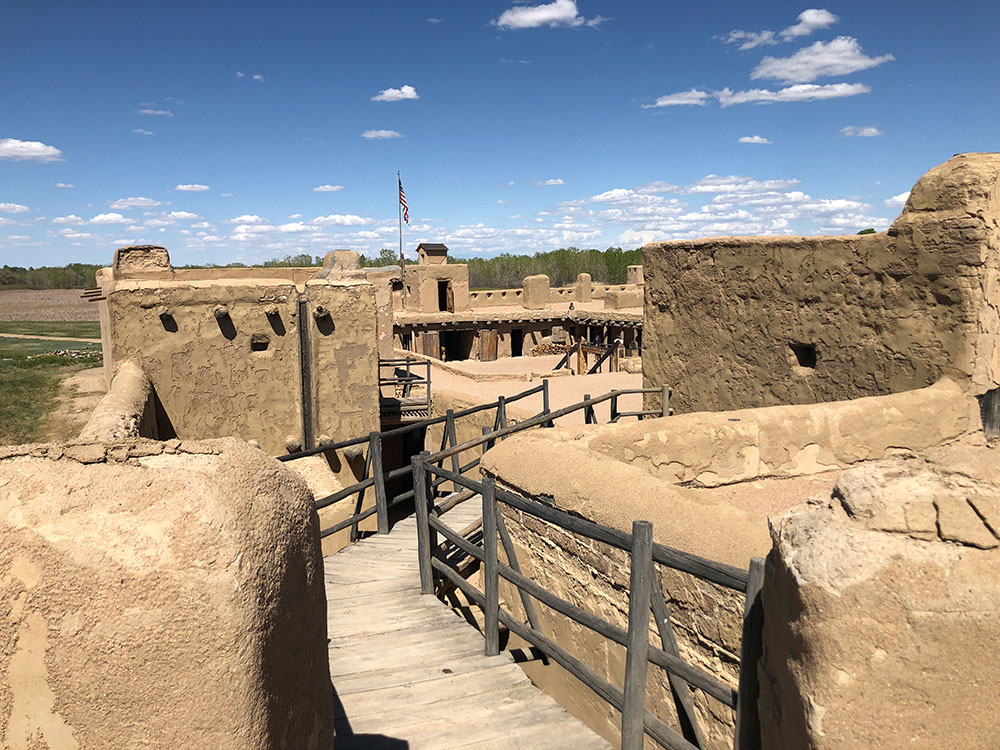
The site was not crowded. Even less crowded was the nature trail that follows the twists of the Arkansas River where the park service has restored the native plants; you walk through riverside groves of cottonwoods. The slightest breeze causes the uniquely hard-edged leaves to rustle with a million tiny clacks which form a hypnotic hum. I was in heaven.
Historic realities, however, soon set in. The trading post was abandoned in 1849 as waves of newcomers brought evermore change to the frontier. Where the Navajo and other native people had once been partners in trade, they were increasingly seen as impediments to progress. The conflict climaxed northeast of Bent’s Old Fort in 1864 at another mostly forgotten site of American horror, some 37 miles north of US 50.
The Sand Creek Massacre was as ghastly and brutal as they come. American troops attacked a village of Cheyenne and Arapaho people, killing over 200. Most were women, children and old people. The next day, the US soldiers tortured and killed many of the over 200 wounded. Official accounts recount how the troops systematically butchered the dead and loaded their horses down with body parts as trophies — something to think about the next time you see a buffed-up John Wayne leading the cavalry on a charge.
As the sun neared the Rockies behind me, I reached the last stop of the day. Just west of easily missed Granada, Colorado (population 500) and right off US 50 is another WWII Japanese-American internment camp. Officially known as the Granada Relocation Center but called “Amache” after a Cheyenne chief’s daughter, this mile-square concentration camp was Colorado’s tenth-largest city in 1943. It held over 7000 people, most US citizens who’d had their constitutional rights plowed under like so much wheat chaff after the local harvest.
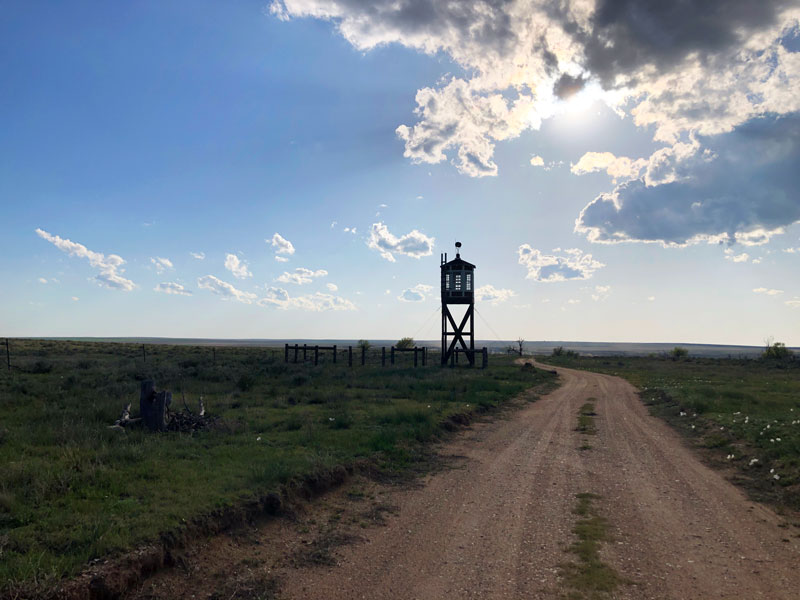
Unlike Topaz, Amache offers a lot for the few people who bother to turn off US 50 each day. Class projects at Granada’s high school have placed signs around the Amache site and rebuilt a few of the mostly razed buildings, including a guard tower. Downloadable driving tours are particularly well done, giving a sense of what it was like to live for years fenced in at this desolate place. Relations with the local townsfolk were at first hostile (there was a near riot when word leaked out that the government was going to build an elementary school for Amache’s children). In a shrewd move, the camp commander allowed the internees to go into Granada to shop. Soon this influx of commerce amidst the wartime privations put some zip into the local economy and people decided that having 7000 captive customers nearby was just dandy.
Day 4: Kansas
Ever since I found the spot on the northern edge of Kansas where Brewster Higley wrote the words for “Home on the Range” in 1872 — and really could imagine deer and antelope playing — I’ve had a soft spot for the state.
The night before, I’d stayed in the unironically named Garden City, a highlight-free town featuring a vast Tyson Foods slaughterhouse. Today US 50 was taking me through a succession of towns where tattered banners, two seasons past their prime, hung limply from light poles, proclaiming the name of the town and the promise “It all starts here!” or some similar banality.
Years of travel writing have given me compassion for the people charged with selling these duds. Exhibit A has to be Dodge City, with the slogan “Get the heck into Dodge!” Yet once in, you’ll still want out.
The local chamber runs a family-friendly tourist season shoot-out on a fake Old West Main Street right downtown. I have two problems with this: a. No one remembers — or misses — the treacly old TV show Gunsmoke, which was set in a heavily fictionalized Dodge City, and b. What’s family friendly about a shoot-out? Maybe if these family-friendly Old West shoot-outs were more realistic, more terrifying, people might be forced to reckon with our violent past and today’s plague of mass shootings. Maybe.
Fortunately, there are rewards for getting out of Dodge. Nine miles west on US 50 you can stop at a site formed by wagons passing by on the Santa Fe Trail. I enjoy the pause, worth it for the walk out into the gently rolling countryside carpeted with spring wildflowers. Signs explain how the wagon ruts in the thin soil started erosion that 150 years later has left deep gullies scarring the landscape.
Among the choices are a couple of fine Mexican joints which highlight an aspect of the Great Plains that’s not exactly forgotten, but is hiding in plain sight.
Few people know that America’s best space museum, the Cosmosphere is right off US 50 in Hutchinson. Cape Canaveral? Houston? Naw, Kansas is the place. This amazing museum is worthy of the hoariest clichés (out of this world anyone?). It covers space exploration starting in the 1950s and gives fair coverage to the US and the Russians. The displays are engaging and accessible as they really know their (right) stuff – the museum has a lucrative sideline making the sets and props used in movies like “Apollo 13” (the actual Apollo 13 capsule is here, too).
It also doesn’t hurt that Hutchinson has oodles of tasty local restaurants serving up the kind of hearty fare that keeps the shock-absorbers in the pickups compressed. Among the choices are a couple of fine Mexican joints which highlight an aspect of the Great Plains that’s not exactly forgotten, but is hiding in plain sight. Scan your way across the AM radio band and you’ll find many Spanish-language stations. Note the storefronts in the decaying centers of many an old farm town and you’ll see that a few of the surviving businesses cater to Hispanic customers. And if you could look inside the slaughterhouses and or venture out onto the farms, you’d see a lot of the actual manual labor in the state is being done by people with roots south of the border. Even if Kansas politics don’t reflect it yet, its economy depends on immigrants to get the job done.
Occupying a verdant and nearly perfect square in the eastern third of the state, Chase County is home to another small and overlooked park service treasure, the Tallgrass Prairie National Preserve. Early writers talk of the great prairies of the plains as oceans, lush with life. Enormous rolling expanses with colors that change by the season and even by day. While much of this majestic beauty has been plowed under and forgotten elsewhere, here across almost 11,000 acres you can savor this grand beauty. I tramped out on the trails at random, attuned to the wildflowers in a spectrum of colors — many so delicate that their time on nature’s stage lasts for only a day. I stopped amidst this playground for hummingbirds and bees and thought of my deeper connection to this place.
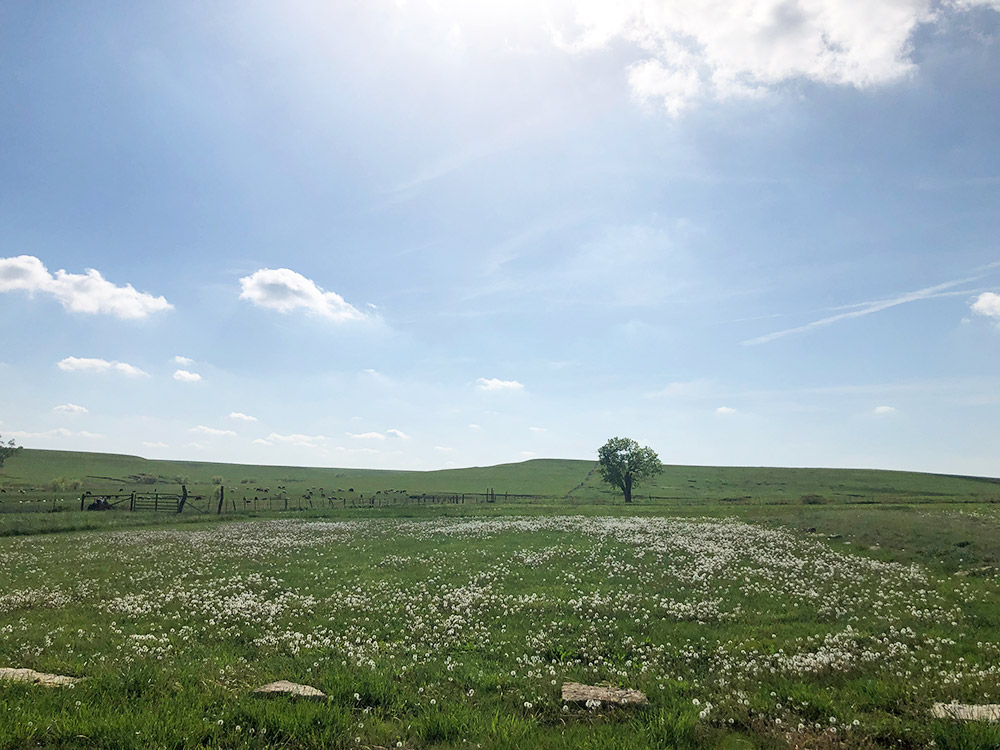
In 1991, William Least Heat-Moon published PrairyErth, a deep map of Chase County and its people. He lived and walked and loved in this place during his research. He was then most famous for his 1981 book “Blue Highways,” about his journey of self-exploration on America’s two-lane, second-tier roads. It was a book that changed my life. If reading Paul Theroux’s The Great Railway Bazaar as a teenager gave my travel desires a “why,” it was Blue Highways that gave them a “how.”
A full tank of gas is all I need to start a journey of surprise and exploration. In four days on US 50, I’d discovered so much that many would rather forget or never knew in the first place. It was the kind of drive that would keep teaching me things long after I’d turned onto another road.
